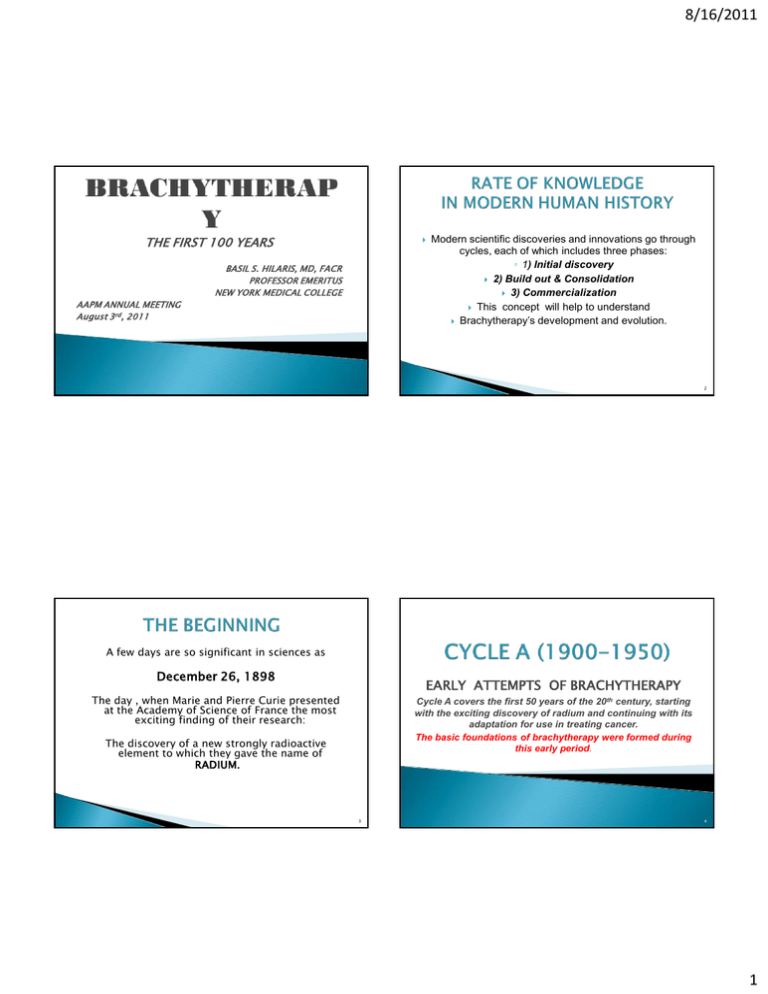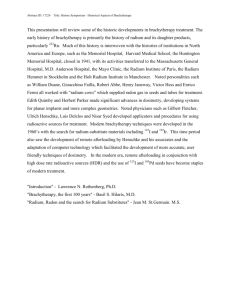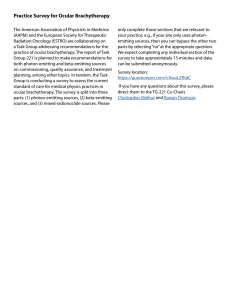8/16/2011 THE FIRST 100 YEARS
advertisement

8/16/2011 THE FIRST 100 YEARS BASIL S. HILARIS, MD, FACR PROFESSOR EMERITUS NEW YORK MEDICAL COLLEGE AAPM ANNUAL MEETING August 3rd, 2011 Modern scientific discoveries and innovations go through cycles, each of which includes three phases: ◦ 1) Initial discovery 2) Build out & Consolidation 3) Commercialization This concept will help to understand Brachytherapy’s development and evolution. 2 A few days are so significant in sciences as December 26, 1898 EARLY ATTEMPTS OF BRACHYTHERAPY The day , when Marie and Pierre Curie presented at the Academy of Science of France the most exciting finding of their research: Cycle A covers the first 50 years of the 20th century, starting with the exciting discovery of radium and continuing with its adaptation for use in treating cancer. The basic foundations of brachytherapy were formed during this early period. The discovery of a new strongly radioactive element to which they gave the name of RADIUM. 3 4 1 8/16/2011 o Soon after the discovery of the radioactive properties of uranium by Henri Becquerel, Marie and her husband Pierre Curie, began to study these invisible rays emanated from uranium. As her daughter Irene later wrote : H. Becquerel (1852-1908) “It is my mother who had no fear of throwing herself without personnel, without money, without supplies, with a warehouse for a laboratory, into the frustrating task of treating kilos of pitchblende in order to concentrate and isolate radium.” In 1903, Becquerel and the Curies, were jointly awarded the Nobel Prize in physics, for the discovery of radioactivity. This event closes the first phase of Cycle A. Pierre Curie (1859-1906) and Marie Curie (1867-1934) with daughter Irene in 1901 The discovery of radium lead immediately to therapeutic trials. Physicians and physicists in many countries, established “Radium Institutes” to treat patients with cancer. It appears that the first treatments were carried out in patients with cancer of the skin, breast and cervix. Thus the second phase starts. We will address some of the most prominent institutions of that time in more details. 5 The first “Radium Institute” in the world was founded by L. Wickham (1861-1913) and P. Degrais(18741942) with Henri Dominici (18671919), as the first clinical director. The Laboratory’s contributions: Demonstrated the different biological effects of the various qualities of radium. Initiated filtration. Introduced the principle of crossfiring. The Laboratory closed in early 1914, in the beginning of WWI. 6 7 The Stockholm school (E. Berven, J. Heyman, M. Strandqvist, R. Sievert, R. Thoraeus), made significant contributions to the Treatment of cancer of the uterus (Stockholm technique); Time-dose fractionation ( Strandqvist curve); Radiation protection issues (Sievert chamber; Thoraeus x-ray filter, freeair ionization chamber, etc) In 1979, the unit of equivalent dose was named after Sievert (Sv). Dr Gosta Forssell (around 1910) 1876-1950 8 2 8/16/2011 The renowned Pasteur Institute and the University of Paris founded the Radium Institute in 1912. It was divided into the CURIE PAVILION (Marie Curie) and the PASTEUR PAVILION ( Claude Regaud). Regaud and his school (A. Lacassagne, Monod, H. Coutard ) exerted an enormous influence on cancer research. They emphasized the experimental side of radiology, particularly “radiobiology” a term introduced by Regaud . Established optimal dose rules and the concepts of protraction and fractionation. Developed principles and treatment techniques for cancer of the cervix (Paris technique) . Holt Radium Institute was founded in 1933 by the fusion of two much older hospitals, the Christie Hospital and the Radium Institute in Manchester. Claude Regaud 1870-1940 Ralston Patterson, built a team of physicists and clinicians (his wife Edith, Margaret Tod, W. J. Meredith and Herbert Parker), who brought the Holt Radium Institute to the forefront of therapeutic radiology. Some of the school’s contributions are: The randomization of patients for scientific comparison by clinical trials Rules for interstitial radium implantation with dose tables which allowed more accurate dosimetry (Paterson-Parker tables) A radium system for intracavitary treatment of cancer of the cervix (Manchester System); and the introduction of points A & B for dose specification. Ralston Paterson 1897-1961 9 In 1915, James Ewing, professor of Pathology at Cornell University Medical Collage became the first director of MH, transforming it from a General Hospital into a leading Cancer Hospital (Memorial Hospital for Cancer and Allied Diseases, known informally as the Radium Hospital or The Bastille.) William Duane, Professor of Physics at Harvard University, who had perfected a radium emanation extraction and purification plant in his laboratory, agreed to install a model of his plant at MH to produce radon seeds for therapeutic use. 10 In 1915 Henry Janeway director of the Radium Department Gioacchino Failla in charge of the radon plant; and since 1919 as director of Physics Department. Edith Quimby joined in 1919 as Failla’s assistant. The use of radon seeds (initially glass and later gold filtered) became very popular in the USA because they were available commercially. Henry H. Janeway 1973-1921 11 Gioacchino Failla 1891-1961 Edith Quimby 1891-1982 12 3 8/16/2011 The society was incorporated on October 26, 1916 in Philadelphia, “to allow workers in different disciplines to meet and exchange experiences and scientific information relative to the therapeutic uses of radium”. William Aikins (1859-1924) of Toronto, was elected as the first President. Given the chance people will often misuse technology and create an enormous amount of mischief. This was the case with radium too! Radium was used in creams, shampoos, toothpastes or as a beverage, to prolong life and prevent aging!. 1934-AMERICAN BOARD of RADIOLOGY (ABR) It was founded in January 1934 “to protect the public from irresponsible practices and to preserve the dignity of qualified professionals”. Since its inception in 1934 the ABR has issued more than 65,950 certificates Since 1994 certificates in Diagnostic Radiology (and various subspecialties), Radiation Oncology and Radiological Physics are issued, time limited (10 years) and requiring recertification. . 13 14 IN SUMMARY In the 40’s and 50’s professional and public concern regarding the harmful effects of radium exposure; frequent radium accidents with disastrous results; technical difficulties regarding radium source construction and integrity; and laborious dose calculations, contributed to a marked decline in brachytherapy's utilization. Lost radium sources frequently ended up in incinerators, trash water or down drains, but one missing source was located inside a pig! Brachytherapy radium based techniques for surface, interstitial and intracavitary irradiation were established. Various systems were developed to calculate radiation dosages within the tumor (Paterson’s, Quimby’s). “Radium Therapy” centers were established throughout Europe and North America In the 1940’s and 1950’s, all was not easy for Brachytherapy. Spectacular technical developments in the field of external beam therapy; Rapid improvements in surgical techniques and anesthesia; and Professional concerns regarding the use of radium, Resulted in a marked decline in utilization of Brachytherapy. 15 16 4 8/16/2011 CHICAGO, NOVEMBER 17, 1958 Modern brachytherapy started with the atomic era and the development of substitute sources for radium and radon. By the 1980’s radium and radon had been almost completely replaced by sources such as Cesium-137, Cobalt-60, Iodine-125 and Iridium-192. Many physicists in biology and medicine, among them W.K. Sinclair, J.S. Laughlin, and G.D. Adams, felt that had no professional identity and that a national organization might speak for the profession in a louder voice than all individuals singly. Gail Adams was the first President, and the initial annual meeting was held near the time of RSNA meeting in Chicago in November. This was the beginning of a remarkably strong educational, scientific, research , and professional association as we witness it today. 17 Modern brachytherapy concepts and techniques were developed and tested at MSKCC by these two scientists and had a major impact on the development of brachytherapy in North America and the rest of the World. In Brachytherapy In Medical Physics 18 1957-The first report on computerized implant-Richard Nelson and Mary Lou Meurk (MSKCC) (The application of automatic computation methods to implant dosimetry). 1962-The first application of computer dosimetry in conjunction with iridium-192 afterloading,-W. Siler (MSKCC) By 1971, applications of computers to problems in radiation therapy, included: Dose-time computations, Treatment planning for internal sources and for external beams, Teaching, Automation of machine control ,and Logging and retrieval of patients chart data. Ulrich Henschke, MD, PhD During the second cycle, new radioactive sources in conjunction with afterloading techniques, and the development of computerized dosimetry renewed enthusiasm for a brachytherapy renaissance. Highlights of each of these developments will be discussed in more details. 19 20 5 8/16/2011 The development of nuclear reactors allowed the production and investigation of several safer radionuclides as alternative to radium: Gold-198 (1947), Cobalt-60 (1948), Iridium-192 (1954), Yttrium-90 (1956), and Cesium-137 (1957) were among the first. Dr Henschke introduced Gold-198 seeds in 1954 (Ohio State University) and Iridium-192 wires/seeds in 1955 (MSKCC), as substitutes for radium needles and/or radon seeds. This represented an improvement over the use of radium and radon sources but radiation exposure still remained a major problem. The method was refined and developed in the late 50’s by Henschke first at Ohio State University and then at MSKCC, in an attempt to: Decrease radiation exposure to physicians, nurses, and other health workers of the institution during a brachytherapy procedure. The three sketches below show the characteristic steps of an afterloading technique: This concept was presented for the first time at the 10TH International Congress of Radiology, in Montreal in 1962. 21 22 Remote afterloading, using small cobalt sources of high activity, moving back and forth to simulate sources of different longer active length, was proposed in 1964 (Radiology,1964), to” Eliminate radiation hazards to health workers, Avoid long hospitalization, and Decrease patient discomfort Iridium-192 seeds were investigated because, compared with radon seeds, had: Lower energy, which made them easier to store, transport and facilitated radiation protection; Longer half-life which allowed their use for longer periods; and a Large cross section which made their activation in nuclear reactors faster and cheaper. Control panel This HDR Remote Afterloader remained in use at MSKCC, from its installation in 1964 until 1979, when it was replaced by a commercial unit. 23 24 6 8/16/2011 Investigation of low energy radionuclides (Iodine-125, Cesium 131, and Xenon 133) was undertaken, in 1966, to explore the possibility of further decreasing radiation exposure. From this experience we concluded that: I-125 sources were a promising substitute for high energy sources; and Radiation exposure to personnel was reduced considerably. A more comprehensive investigation was conducted by Jean St Germain, Garrett Holt and Basil Hilaris in 1968. We investigated radiation protection issues; seed design, construction, calibration and dosimetric issues; and obtained clinical experience with I-125 ( in 234 pts) and HDR remote afterloading (in 196 pts). USDHEW response was as follows: ‘”The section on Iodine-125 appears to be significant for brachytherapy; The section on HDR remote afterloading, is not because the traditional techniques with radium are already well established and very effective”. 25 The role of brachytherapy in H&N cancer was reestablished after the introduction of afterloading techniques and artificial radionuclides. 26 The first postoperative afterloading H+N implant, using Gold-198 seeds, was performed by Henschke at Ohio State University in 1953. Modern manual afterloading techniques in conjunction with Ir192 and conservative surgery ((lumpectomy) revived interest in breast brachytherapy. Harris et al in 1980 reported 5 year local control from the Joint Center: T1=96% and T2=90% Pierquin in 1983 reported 10 years local control in 408 patients from Creteil Institute: T1=92%, T2=91% and T3=85%. 27 28 7 8/16/2011 The acceptance of “lumpectomy” as the treatment of choice in early breast cancer, allowed the use of limited irradiation to the tumor site in conjunction with ERT. ACCELERATED PARTIAL BREAST IRRADIATION (APBI) a total dose of 34 Gy, twice a day x 5 days on an outpatient basis Example of permanent I-125 implant The largest experience with permanent I-125 and temporary Ir-192 implants (in over 1000 pts) was accumulated at MSKCC during the 60’s to 80’s. The long term results for selected patients with limited pulmonary reserve who could not tolerate resection (stage I and II) were promising with an overall 5-year survival of 32%. The availability of newer techniques, including IMRT, improved dosimetry, and the integration of chemotherapy have almost completely replaced BRT today. INTRAOPERATIVE BREAST RADIATION THERAPY (IORT): a single dose of 10-20 Gy/30 minutes, at the end of lumpectomy 29 30 In 1969 Dr Whitmore at MSKCC agreed to a collaborative study with our group to investigate I-125 in conjunction with pelvic lymphadenectomy for the treatment of cancer of the prostate, as an alternative to radical prostatectomy. Between 1970 and 1980, 600 patients were treated . Survival was for T1 96%, T2 76%, T3 69% and T4 13%. Several conclusions were drawn from this experience Tumors that were treated to a minimum of 160Gy were better controlled than tumors receiving a lesser dose. Patients with positive nodes would soon develop distant metastases. Small tumors, localized to prostate were optimal candidates. The technique was difficult to learn and misapplications resulted in its decline by early 80’s. Credit belongs to Dr Ragde and Dr Blasko in Seattle, who in 1987 adopted transrectal ultrasound and computer technology to I-125 prostate brachytherapy. In 1978 Nisar Syed and sixty-seven other physicians founded the American Endocurietherapy Society in California. By 1985 the membership had grown to 395 practicing radiation oncologists, medical physicists and radiation biologists throughout the USA. In 1997-the society was renamed American Brachytherapy Society 1979-BRACHYTHERAPY SERVICE AT MSKKC The first modern BRT service in the USA was established on July 1st, 1979 at MSKCC. Many members of the service had subsequently very successful careers. You will recognize the following names: Dr D. Nori (NYH), Dr B. Vikram (IAEA & NCI), Dr. S. Nag, Dr. A. Martinez, Dr. L. Harrison (President of ASTRO), Dr. M. Zelefsky (editor of Brachytherapy Journal) Sitting: Drs. H Brenner, B. Hilaris & D. Nori. Standing: Drs A.Tankenbaum, L. Linares, Surgical resident & Dr D. Greenblatt 31 32 8 8/16/2011 IN SUMMARY Modern Brachytherapy wisely applied and properly regulated contributed to improved treatment techniques and advanced the cause of cancer control. New radionuclides with lower energy, commercially produced HDR units, optimization of BRT, 3-D BRT planning and ultrasound based real-time planning became available, and practiced not only in major academic centers, hospital based, but also in private practice. Computer technology and the resulting ability to produce very accurate three dimensional radiation dose distributions within the patient; and standardization of brachytherapy techniques, allowed for more uniform practice and better use of integrated treatments. This amplified role of brachytherapy is reflected: in the considerable brachytherapy literature; the formation of the American Brachytherapy Society; and its dedicated Brachytherapy Journal. Everything therefore promises a bright future for Brachytherapy. 33 As we enter the new millennium, CYCLE-C of brachytherapy is due. Several impending risks, are threatening medicine and its practitioners. Constant warnings about radiation overdoses, lack of safeguards, and software flows, have forced Federal and other government and state agencies to take steps to more stringently regulate medical radiation. There is a fast-rising cost curve on track that we have to deal with in our specialty. The political outlook is uncertain and it appears that treatment decisions will be made by protocols with several layers of midlevel administrators. The value of Brachytherapy should never be taken for granted. The decisions to be made and the likely consequences of those decisions, will shape the future of Brachytherapy, which in the last 100 years has without doubt saved countless lives, but it must undergo serious restructuring in order to address the new century. But, in spite of all adversities, Brachytherapy, continues to be intellectually challenging and with cutting-edge technology it will continue to be a uniquely rewarding specialty. 34 If something I’ve said energizes you, then I’ve done my job. Brachytherapy’s future as a specialty depends on you and your work! THANK YOU 35 9

